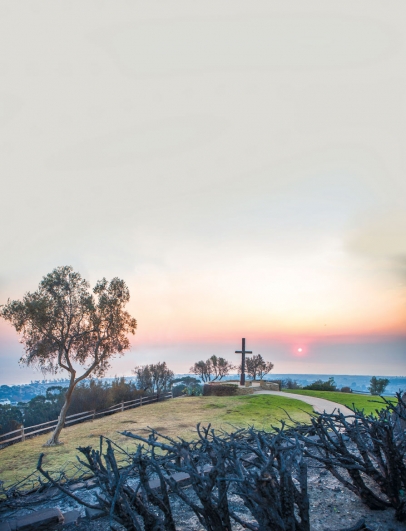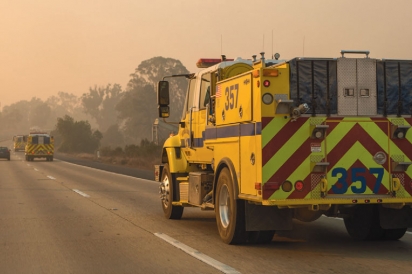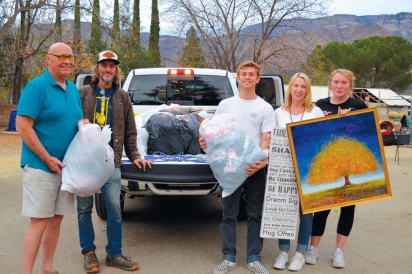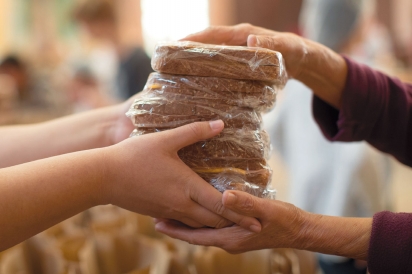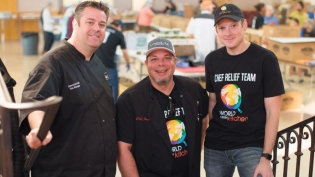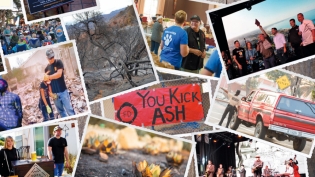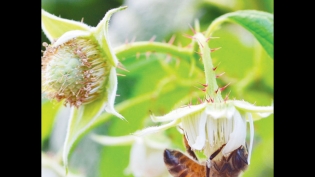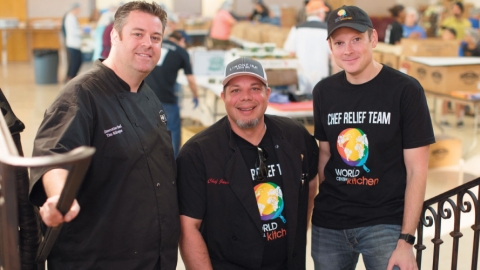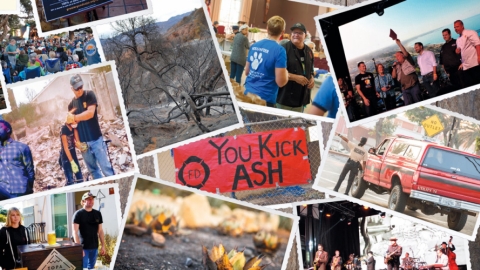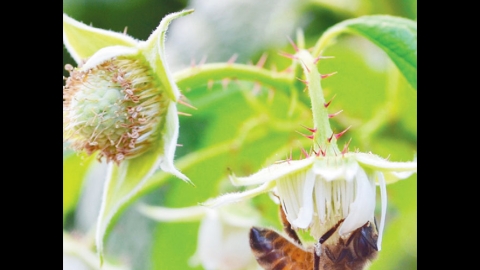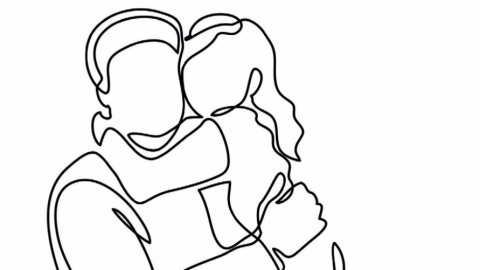Community’s Spirit Glows in Wake of Fire
Fire came like a living thing. Flames rose to heights flames should never rise to. Burning embers like angry fireflies. Cars with windshields of flame. Schizophrenic Santa Ana winds, so dry and fast and unforgiving. Many had little to no warning. Orange on the distant hillside, then Hell in your backyard. Neighbors banged on each other’s doors. They gathered each other’s things. They turned hoses on each other’s roofs, dug trenches, hacked away brush. A man stomped out a grass fire while his beard sizzled. There were miracles (thank you, first responders) and there were not.
Hundreds of homes lost, nearly 282,000 acres burned, 40 days.
“The Thomas Fire truly was monumental,” says Dr. Sean Anderson, chair of the Environmental Science and Resource Management Program at California State University, Channel Islands. “We could see it from space.”
Anderson is studying the impacts of the fire on plants and animals, with an eye to recovery. It will not be a short-term study.
“It was the largest fire in recorded California history,” says Anderson at a Ventura Land Trust Environmental Speaker Series event in January. “The story is still unfolding before our eyes.”
It is quiet now, the raging Thomas Fire finally snuffed, but if you drive along Ojai– Santa Paula Road on a Friday morning as I did, as it rises outside Santa Paula toward Thomas Aquinas College (near where the fire started), you will pass soldierly rows of trash barrels facing blackened, moonscape hills. Friday is trash day. Ventura County residents will long be surprised by the strange juxtaposition of disaster and a life that goes on. The story will continue to unfold before our eyes. And though the roots of the story are buried in unfathomable sadness, from that sadness has sprouted so much good.
On this Friday morning, Trevor Quirk sprawls in a chair in the parking lot of Stagecoach Station in Upper Ojai. He has just been asked what he sees as the takeaway lesson of the Thomas Fire (and the Montecito mudslides that followed). Quirk is a straightforward fellow. Along with friend Justin Homze, he inadvertently (“It just grew and grew”) founded the Upper Ojai Relief Foundation, a grass-roots group that has done whatever it takes to help the residents of Upper Ojai, from fighting the fire to providing temporary living space for horses. When people lose everything, they need everything.
There are plenty of takeaways, says Quirk, but here’s one: “There is so much good in the world. People really want to help those in need.” Since December 4, far more good than can named has unspooled in Ventura County, but here’s a sampling.
Food poured in, streaming into all manner of venues. In addition to efforts by local chefs and volunteers through the World Central Kitchen, operating out of the kitchen at Ventura’s San Buenaventura Mission, restaurants fired up their grills and home cooks did the same. Local suppliers kept the ingredients coming: Petty Ranch, McGrath Family Farm, Rio Gozo Farm, Limoneira, FOOD Share, Trader Joe’s, a host of closed schools with food on hand and no students to feed.
People opened their homes to those who had lost their homes. Local businesses gave away everything from jackets to jewelry. They also organized strike teams—first to fight the fires, then to help with cleanup and recovery. Local groups mobilized, including the 805 Strong Network, the Local Love Project, Help California (an initiative of Iron & Resin in Ventura), the Kirwin International Relief Foundation and the Upper Ojai Relief Foundation.
Some of these groups were already in place. Some bloomed out of happenstance and care. They found housing for those who lost their homes. They coordinated fundraisers (and still are). They donated supplies. Perhaps most important, they served as the good kind of ground zero for the hundreds of people asking how they could help.
“The resiliency and strength I’ve seen is just unprecedented,” says Ventura Deputy Mayor Matt LaVere at the January meeting. To a capacity audience at the Thomas Fire Benefit Festival in February, he again expressed his pride in the community’s response.
The efforts have been wide-ranging, but so often the foundation has been simple: neighbors helping neighbors. Not that the outside world hasn’t pitched in. Checks arrived from around the globe. A San Clemente man sent an envelope with three $100 bills to Pete’s Breakfast House in Ventura. Please use this to buy breakfasts for the displaced.
One day, in the Stagecoach Station parking lot, Quirk spotted a truck with Colorado plates, packed with supplies. The two women had their work boots on. We saw you on Facebook, and we wanted to help.
Social media. Welcome to the new face of disaster relief. The visible infrastructure of the Upper Ojai Relief Foundation consists of a parking lot, a few storage pods and folding tables, and Quirk’s and Homze’s phones. (At press time, the foundation was planning to move to Summit Elementary School.) It has proven a ruthlessly efficient mode of action. Tap, tap, tap. Hey, Upper Ojai, plastic bins needed at the Station. Five minutes later, bins arrive.
“We’re agile,” smiles Homze.
Angela Rockett Kirwin is co-founder, along with husband, Mark, of the Ventura-based Kirwin International Relief Foundation. KIRF is a fancy name for a simple thing: two people who want to help, and know how to use hustle and local contacts. When Ventura’s Hawaiian Village Apartments burned to the ground, 52 units in all, the Kirwins contacted the property manager. Here’s how much money we have. Which residents need help the most? The manager provided the numbers, and relief, not just in cash, was at hand.
“It’s personal,” says Rockett Kirwin. “It’s not some strange person contacting them. I’m not a volunteer from another state talking to strangers. I’m someone who lives here, working through mutual friends to find people who need help. And what’s super important to a donor, every person we give aid to has been vouched for by a person that I know and trust. See how simple it is?”
KIRF gave one to three $500 Target or Walmart gift cards to families in need after the fires and in February handed out another round. “Now we are trying to accumulate enough funds to help people who need help in the next disaster,” Rockett Kirwin says.
These grassroots doers, they’re also here to stay.
Says Kat Merrick, founder of Totally Local VC, who started the Local Love Project in response to the fires, “This is a new and permanent part of our Totally Local VC mission. It will remain in place so that the next time our community is hit by disaster, or in a time of need, we can be ready and there to help.”
And our community has not forgotten this time. On January 1, Ventura’s Spencer Makenzie’s Fish Company began donating 50 cents of every bottle of Sweet Chili Fire hot sauce they sell to a fund. On December 31, the money will be given to the family of firefighter Cory Iverson, who perished in the fire.
“Ventura is stronger, and a kinder place to live,” says Rockett Kirwin. “It’s better than it was. And through this awful tragedy, friends and retailers and nonprofits have met each other. Now we have this informal network of aid that’s ready for the next challenge.”
And there will be a next challenge.
“We live in an area where fire is natural,” says CSUCI’s Anderson.
“The same with mudslides and earthquakes. Crazy powerful forces. These forces, you cannot win.”
The thought is daunting. But what you can’t defeat, you can outlast. Sitting in the Stagecoach Station parking lot, Quirk looks up from his weathered hands.
“We’re not stopping. We are going to be like that guy who sleeps on your couch, the one who comes for a day and stays for months.”


